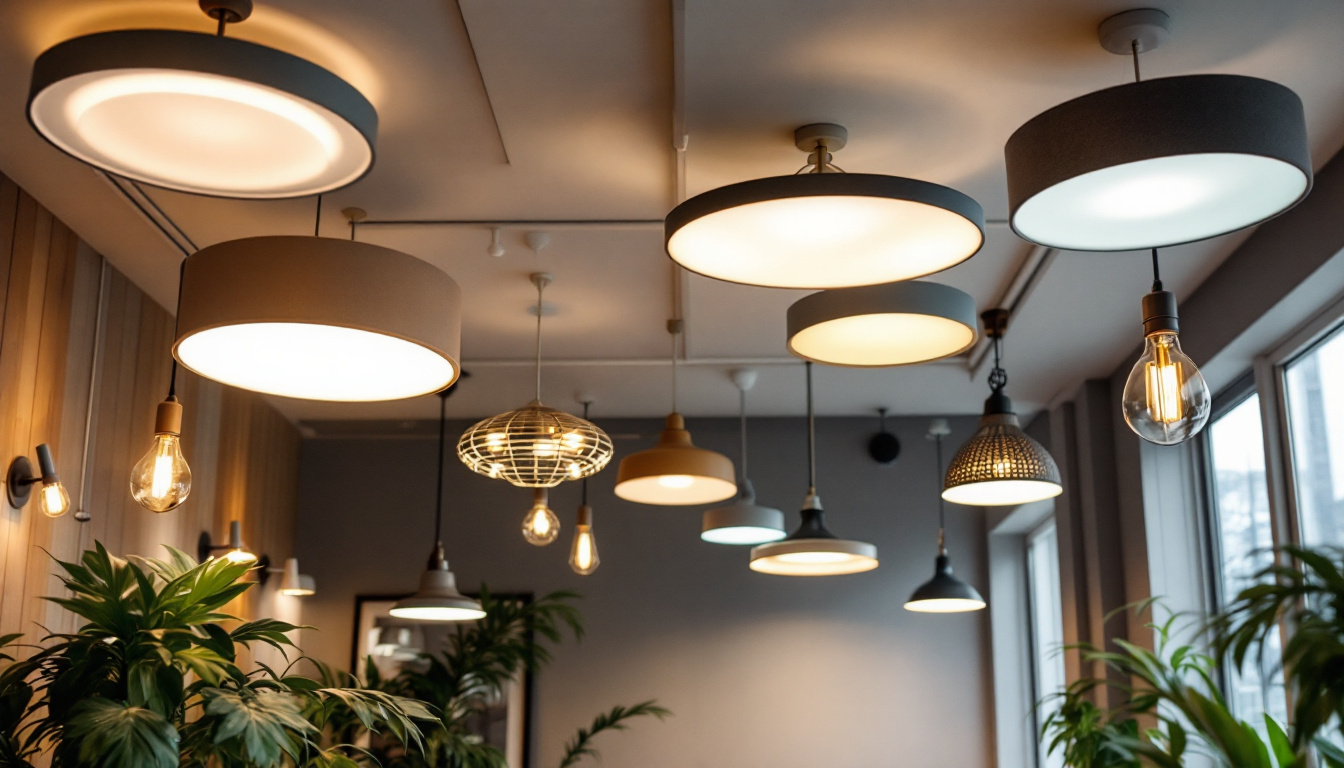
As the world of interior design and architecture continues to evolve, the importance of lighting has become increasingly evident. Ceiling lights play a crucial role in enhancing the aesthetics and functionality of a space. For lighting contractors, staying updated on the various types of ceiling lights is not just beneficial; it is essential for maintaining a competitive edge in the industry. This article delves into the different types of ceiling lights and why it is vital for lighting contractors to keep abreast of the latest trends and technologies.
Ceiling lights serve as a primary source of illumination in residential and commercial spaces. They can transform a room’s ambiance and functionality, making it essential for contractors to understand the various options available. From traditional fixtures to modern designs, the variety of ceiling lights is vast, and each type has its unique characteristics and applications.
Ceiling lights are not merely functional; they also play a significant role in the overall design of a space. They can highlight architectural features, create focal points, and contribute to the mood of a room. For instance, a well-placed chandelier can add elegance to a dining area, while recessed lighting can provide a sleek, contemporary look in a modern kitchen. The choice of materials and finishes, such as polished metals or matte textures, can further influence the perception of space, making it feel either cozy or expansive.
Understanding the interplay between light and design is crucial for lighting contractors. Knowledge of different ceiling light types allows contractors to make informed recommendations to clients, ensuring that the lighting complements the overall aesthetic of the space. Additionally, the color temperature of the light can affect how colors appear in a room, making it important to consider the intended use of the space. For example, warmer tones may create a relaxing atmosphere in a bedroom, while cooler tones can enhance focus in a home office.
There are several types of ceiling lights, each with its unique characteristics and applications. Below, we explore some of the most popular types that every lighting contractor should be familiar with.
Flush mount lights are a staple in many homes, providing a clean and unobtrusive look that works well in low-ceilinged rooms. These fixtures sit directly against the ceiling, making them ideal for areas where headroom is a concern. On the other hand, pendant lights offer a more decorative option, often used in dining areas or kitchens to create visual interest. They hang from the ceiling and can be grouped together for a dramatic effect or used individually as statement pieces. Understanding the nuances of these different types of ceiling lights allows contractors to tailor their designs to meet the specific needs and preferences of their clients, ensuring a perfect blend of form and function.
Chandeliers are often considered the epitome of elegance in lighting design. These fixtures typically feature multiple arms and are adorned with decorative elements such as crystals or glass. They are commonly used in dining rooms, entryways, and grand spaces where a statement piece is desired.
Chandeliers come in various styles, from traditional to modern, allowing them to fit seamlessly into different design themes. For contractors, understanding the versatility of chandeliers is essential for meeting diverse client preferences. Whether a client desires a classic wrought-iron chandelier or a sleek, minimalist design, the options are plentiful.
When installing chandeliers, contractors must consider the height of the ceiling and the overall scale of the room. A chandelier that is too large can overwhelm a space, while one that is too small may not provide adequate illumination. Proper placement and installation are crucial for achieving the desired effect.
Flush mount lights are a popular choice for spaces with lower ceilings. These fixtures sit directly against the ceiling, providing a clean and unobtrusive look. They are ideal for hallways, bedrooms, and smaller rooms where space is limited.
Many flush mount lights are now available with energy-efficient LED options. This not only reduces energy consumption but also extends the lifespan of the fixture. Contractors should be aware of the latest energy-efficient technologies to offer clients sustainable lighting solutions.
Flush mount lights come in various designs, from simple and functional to decorative and stylish. This variety allows contractors to match fixtures with the overall decor of a space, ensuring that the lighting enhances rather than detracts from the design.
Pendant lights are versatile fixtures that hang from the ceiling, typically suspended by a cord, chain, or rod. They are available in various styles and sizes, making them suitable for a wide range of applications, from kitchen islands to dining areas.
Pendant lights can serve as striking focal points in a room. By selecting the right size and design, contractors can create visual interest and draw attention to specific areas. For example, a cluster of pendant lights above a kitchen island can create a stunning centerpiece.
Incorporating pendant lights into a layered lighting design can enhance the functionality of a space. By combining pendant lights with other types of lighting, such as recessed or wall-mounted fixtures, contractors can create a well-lit environment that caters to various activities.
Recessed lighting, also known as can lights or pot lights, is installed into the ceiling, providing a sleek and modern look. These fixtures are often used for general lighting or to highlight specific areas of a room.
One of the primary advantages of recessed lighting is its ability to save space. Since the fixtures are installed flush with the ceiling, they do not protrude into the room, making them an excellent choice for areas with low ceilings or where a minimalist aesthetic is desired.
Recessed lights can be adjustable, allowing contractors to direct the light where it is needed most. This feature is particularly useful in spaces such as galleries or living rooms, where highlighting artwork or architectural features can enhance the overall design.
Track lighting consists of multiple light fixtures mounted on a single track, allowing for flexibility in directing light. This type of lighting is often used in galleries, retail spaces, and kitchens, where adjustable lighting is beneficial.
One of the significant advantages of track lighting is its adaptability. Contractors can easily reposition the fixtures along the track to suit changing needs or design preferences. This flexibility makes track lighting an excellent option for clients who may want to update their lighting without extensive renovations.
Track lighting is particularly effective for highlighting specific features in a room. By directing the light toward artwork, architectural details, or decorative elements, contractors can create a dynamic and visually appealing environment.
Surface mount lights are similar to flush mount lights but are typically larger and can provide more substantial illumination. These fixtures are mounted directly onto the ceiling and are available in various styles and designs.
Surface mount lights are often used in commercial settings, such as offices and retail spaces, where bright, even illumination is required. For contractors, understanding the specific lighting needs of commercial clients is crucial for recommending the right fixtures.
When selecting surface mount lights, contractors should consider the overall design of the space. These fixtures can range from utilitarian designs to more decorative options, allowing for customization based on the client’s preferences.
As technology continues to advance, smart ceiling lights have emerged as a popular choice for modern homes. These fixtures can be controlled via smartphone apps or voice-activated devices, offering convenience and flexibility.
Smart ceiling lights can be integrated into home automation systems, allowing homeowners to control their lighting remotely. For lighting contractors, understanding the capabilities of smart lighting technology is essential for providing clients with innovative solutions that enhance their living experience.
Many smart ceiling lights come with energy-saving features, such as scheduling and dimming options. This not only helps homeowners reduce energy consumption but also allows contractors to promote sustainability in their lighting designs.
For lighting contractors, staying informed about the latest trends and technologies in ceiling lights is crucial for maintaining a competitive edge. The lighting industry is constantly evolving, with new designs, materials, and technologies emerging regularly.
Participating in workshops, trade shows, and online courses can provide valuable insights into the latest developments in lighting design. By investing in continuing education, contractors can enhance their skills and knowledge, ensuring they remain at the forefront of the industry.
Building relationships with manufacturers, suppliers, and other industry professionals can provide contractors with access to the latest products and innovations. Networking can also lead to collaborations and partnerships that can benefit a contractor’s business.
Understanding the different types of ceiling lights and their applications is essential for lighting contractors. As the industry continues to evolve, staying updated on trends and technologies will enable contractors to provide clients with innovative and effective lighting solutions. By embracing the diverse range of ceiling lights available, contractors can enhance their design offerings and ensure client satisfaction.
In a competitive market, knowledge is power. Lighting contractors who invest time in understanding the nuances of ceiling lights will not only improve their craft but also elevate their business to new heights. Whether it’s through education, networking, or simply keeping an eye on emerging trends, staying informed is key to success in the ever-changing world of lighting design.
Ready to take your lighting projects to the next level? At LumenWholesale, we provide lighting contractors with an exceptional range of top-quality, spec-grade ceiling lights at unbeatable wholesale prices. Say goodbye to local distributor markups and hello to superior products that meet the highest industry standards. With our hassle-free bulk buying and free shipping, you can trust that you’re getting premium lighting at the best value — without hidden fees or compromises. Elevate your lighting designs today and experience the perfect blend of quality, affordability, and convenience. Visit LumenWholesale for Wholesale Lighting at the Best Value.

Discover the essential insights lighting contractors need when choosing ceiling fans for shops.

Explore the essential role of the Design Light Consortium in shaping sustainable lighting practices.

Discover essential tips and expert techniques for lighting contractors to efficiently replace fans.

Discover how linear LED ceiling lights can boost efficiency for lighting contractors, reduce energy costs by up to 50%, and enhance project quality—learn more now!.